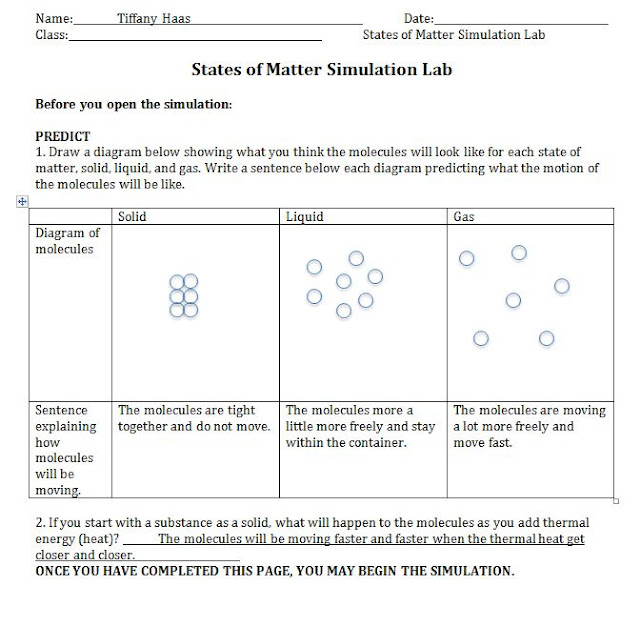Activity 6
1. Convert 0°F, 32°F, 70°F, and 212°F to Kelvin
0 degrees Fahrenheit= 255.22 degrees Kelvin
32 degrees Fahrenheit= 273 degrees Kelvin
212 degrees Fahrenheit= 373 degrees Kelvin
2. Complete the Teaching Idea: States of Matter Simulation Lab by Kelly Vaughan. Complete the lab worksheet as if you
were a student, and then post this on your blog.
You can scan it or just take a picture of it.
3. In the States of Matter simulation, choose the Solid, Liquid, and Gas Tab at the top of the screen. Choose the water molecule and cool the water to 0 K. Describe how the water molecules are aligned and attracted to each other. Which atoms are attracted to which other atoms?
The molecules are barely moving and the hydrogen molecules are drawn to the oxygen molecules. Cold is attracted to cold and the hot is repelled from the hot.
4. Switch to the Phase Changes Tab on the States of Matter simulation. Notice how on the bottom right there is a small red dot that indicates where the system is at as far as temperature, pressure and state of matter. Play with the simulation to notice changes, notice that when you push down the pressure can go way up and explode the box. On your blog, report a temperature and pressure required to make oxygen a liquid. This is sometimes how the oxygen exists in pressurized oxygen tanks, perhaps like ones you may use to go diving.
60 ATM
57 K
5. List and describe at least two Science Standards that this activity addresses.
A. 4.3 When investigating a science-related probelm decide what data can be collected to determine the most useful explanations.
We had to investigate throughout this experiment and explain what was happening.
A. 8.6 Use models and explanations to predict actions and events in the natural world.
We had to predict in the worksheet and describe states of matter which happens in the natural world.




No comments:
Post a Comment